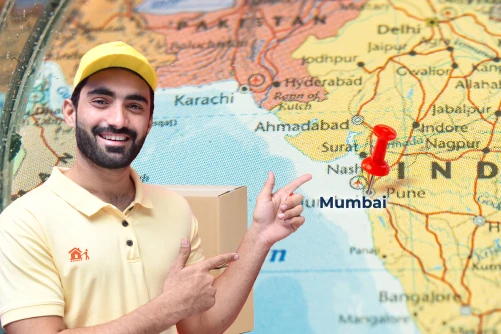Shifting is an important phase of life, and when you have to change a city like Mumbai, it can be full of excitement and challenges. The city is a dream city for many people, especially those looking for a career in the entertainment industry. Mumbai experiences scorching summers with high humidity. It expects heavy rainfall from June to September that sometimes can lead to potential flooding. It is a bustling metropolis with non-stop energy. If you move here, be prepared for the crowds. It is a melting pot of cultures, as people from all over the country move here to give their careers a new direction. The city is known for iconic foods like Vada Pav, Pav Bhaji, and more. If you are planning to move here, you need some more details, and this moving guide will help you explore the city in detail-

Cost of living
The cost of living in Mumbai is considered high primarily due to the high demand for housing and limited space. However, transportation is affordable, as multiple public transportation options are available in the city. Here is the breakdown of the cost of living in Mumbai.
| Category | Approximate Monthly Cost (INR) |
|---|---|
| 1BHK Rent (outside city center) | ₹15,000 |
| Utilities (monthly) | ₹3,000 |
| Internet (monthly) | ₹800 |
| Public transport (monthly pass) | ₹1,500 |
| Groceries (monthly) | ₹6,000 |
| Restaurant meal (mid-range) | ₹800 |
| Cinema ticket | ₹300 |
Job Market & Economy
The economy and job market of Mumbai are dynamic and multifaced. Mumbai is considered as the financial capital of India. The city is home to major financial institutions like the Bombay Stock Exchange, the Reserve Bank of India, and several other banks. The city is a major hub for businesses across various sectors including, IT, manufacturing, entertainment, and more. The strong demand for jobs in Mumbai results in high competition, and growing demand for skilled professionals.
Education system
Mumbai has a mix of private and public institutions offering a range of options from pre-school to higher education. There are a wide variety of schools, affiliated with state boards (Maharashtra State Board), Central Board of Secondary Education (CBSE), and the Indian Certificate of Secondary Education (ICSE). The residents face high competition to get admission for their children in top schools and colleges.
Here is the list of some of the top schools in Mumbai –
- Dhirubhai Ambani International School
- Aditya Birla World Academy
- Bombay Scottish School
- Jamnabai Narsee School
- The Cathedral & John Connon School
- Ecole Mondiale World School
- Campion School
Mumbai is home to some top colleges, universities, and higher education that offer a diverse range of academic programs. Here is the list of some best educational institutions in the city –
- University of Mumbai
- Indian Institute of Technology Bombay (IIT Bombay)
- Institute of Chemical Technology (ICT)
- St. Xavier’s College
- Tata Institute of Social Sciences (TISS)
- Narsee Monjee Institute of Management Studies (NMIMS)
Healthcare facilities
There is a mix of public and private institutions in Mumbai providing top-quality medical care. There are several private hospitals, clinics, and healthcare centers that have state-of-the-art equipment and technology. The cost of private healthcare can be expensive, and it is not accessible to many. There are government hospitals as well in the city providing free or low-cost healthcare services.
Here is the list of some of the top hospitals in the city –
- Kokilaben Dhirubhai Ambani Hospital
- Nanavati Super Speciality Hospital
- Lilavati Hospital and Research Centre
- Bombay Hospital and Medical Research Centre
- Fortis Hospital, Mulund
- Jaslok Hospital and Research Centre
- P.D. Hinduja Hospital
Top Locations to Live in Mumbai
Finding a perfect location where you can rent a house in a city like Mumbai can be challenging. But we can make your home search easy by listing top locations in the city –
- Colaba – This is located in South Mumbai and it is a historical area with colonial architecture. In this locality, you will find upscale boutiques and fine dining options.
- Beach Candy – This location is known for luxury residences, hospitals, and proximity to the sea.
- Bandra – This vibrant area has a mix of residential, commercial, and entertainment options. It is a well-known location in the Western Suburbs of Mumbai.
- Chembur – If you are looking for a well-developed area with good connectivity, Then Chembur should be the first option.
- Juhu – This locality is famous for its beach, celebrity residences, and upscale restaurants.
- Powai – If you want a house in a planned township, you can start finding a house in Powai. There are modern apartments, IT parks, and a lake in the locality.
- Malabar Hill – This is an affluent neighbourhood with high-end amenities. You can enjoy the stunning views and green spaces.
Traffic and Transportation
Mumbai’s transportation system is efficient as the public transportation system is robust, and there are numerous options available in the city. However, the city experiences severe traffic congestion, especially during rush hours, whether you are traveling via local train, bus, or your own vehicle.
There are several options for public transportation including local trains, buses, metro, and monorail.
Climate and Weather
Mumbai experiences a tropical monsoon climate with distinct wet and dry seasons. Summers are hot and humid, with temperatures going above 35OC. During monsoon, Mumbai experiences heavy rainfall with intense downpours. The city only experiences mild winters. Excessive rain can lead to flood in some areas.
Things to do in Mumbai
When you move to a new city, exploring it will help you connect with everything new. Here are some things you can do when you move to Mumbai –
- Visit the iconic landmark Gateway of India.
- Take a stroll along Marine Drive which is an iconic promenade and known for beautiful views.
- Explore the ancient cave temples at Elephanta Caves that are dedicated to Lord Shiva.
- Visit Haji Ali Dargah which is located on an islet off the coast and can only be accessible during low tide.
- Relax on the golden sands of Juhu Beach enjoy a variety of street food and watch the sunset.
- Enjoy the breathtaking views of the city skyline while driving or walking across the Bandra-Worli Sea Link.
Pros and Cons of Living in Mumbai
When you move to a new city, you only want to learn about the pros of the place. Learning about the cons of living in the city is also essential to be prepared for the challenges.
| Pros of living in Mumbai | Cons of living in Mumbai |
|---|---|
| Mumbai is financial capital of India offering wealth of job opportunities | The cost of living in Mumbai is high with expensive housing cost |
| City boasts a rich cultural diversity | The city faces severe traffic congestions during rush hours |
| The city has dynamic lifestyle with thriving art scene, vibrant nightlife and more | Mumbai experiences hot and humid weather |
| Public transportation system is well-developed in Mumbai | Job market in the city is highly competitive requiring high qualification |
| The city is home to some of the best hospitals and healthcare facilities | Mumbai faces challenges such as air and water pollution |
FAQs about Mumbai
Is it expensive to live in Mumbai?
Yes, Mumbai is one of the most expensive cities in India. If you move here, you can expect to pay a premium for housing, transportation, and dining out.
Are there any affordable locations to live in Mumbai?
Yes, areas like Thane, Navi Mumbai, and Mira Road offer affordable housing options.
Is Mumbai a safe city?
Generally, it is safe to live in Mumbai, but petty crimes like pickpocketing can occur in crowded areas.






 House
House  Office
Office  Car
Car  Bike
Bike 

